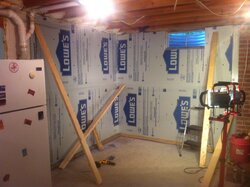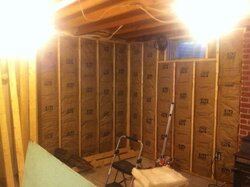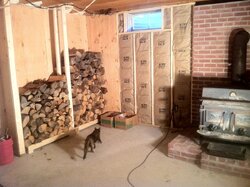mass_burner
Minister of Fire
I insulated the walls with 2 inch foam insulation which I glued to the wall. I tuck taped all the seams. I spray foamed at top, bottom and corners. I did the same in between the rafters at the top of the walls.. I added pink insulation on top of the foam insulation between the rafters. It makes all the difference. All they had before was 1 inch white foam on the walls (which doesn't do much to keep the cold out and heat in).
I swear you can't feel a draft at all (except when the stove is running, then you feel the cold air coming down the stairs and the heat going up).
If I could., I would have insulated the cement floor as well, but I don't have much head room. So I'll have to settle for ceramic tiles and throw rugs.
We're expecting some -40C weather for the next couple of days....thank god for that stove!
"Then I built my 2x4 walls and added pink insulation between, then the sheetrock panels."
Is there really a need for pink stuff on top of foam board? I would worry about mold








 , the humidity would be higher and mold will indeed grow on the foam board. Humidity migrates to a cooler surface and will easily go through drywall. All that is highly unlikely if you have a wood stove downstairs but I just wanted to make sure you are aware.
, the humidity would be higher and mold will indeed grow on the foam board. Humidity migrates to a cooler surface and will easily go through drywall. All that is highly unlikely if you have a wood stove downstairs but I just wanted to make sure you are aware.